The Seismic Performance and Global Collapse Resistance Capacity of Infilled Reinforced Concrete Frames Considering the Axial–Shear–Bending Interaction of Columns
Abstract
1. Introduction
2. Model Method for RC Columns Considering the Axial–Shear–Bending Interaction
2.1. Stimulation for the Shear Deformation of RC Columns
2.1.1. Mechanism of the Interaction between Axial and Bending Deformations
2.1.2. Limit Curve of a Shear Spring Based on Limit-State Uniaxial Material
2.1.3. The Calculation of Degrading Stiffness
2.2. Modeling of Column Axial Failures
3. The Prototype Structures and Numerical Models
3.1. The Prototype Structures of the Infilled RC-Frame Structure
3.2. Three Numerical Models Based on OpenSees
4. Comparison of Test and Numerical Stimulation Results
5. Performance Analysis of Infilled RC Frame
5.1. The Incremental Dynamic Analysis of a Structure during Earthquake Events
5.2. Structural Degradation Characteristics under Static Load
5.3. Evaluation of Seismic Performance and Global Collapse Resistance Capacity of Structures
5.3.1. The Selection of Ground-Motion Records
5.3.2. Nonlinear Dynamic Analysis during Fortification and Rare Earthquakes
5.3.3. The Results of the Incremental Dynamic Analysis
5.3.4. Assessment of Collapse Resistance Capacity
6. Conclusions
- (1)
- When the PGA of the ground motion is less than 0.2 g, the IDA curve for the model considering the axial–shear–bending interaction of RC columns is consistent with the model that does not consider the axial–shear–bending interaction of RC columns, indicating that the axial–shear–bending interaction of RC columns does not have an apparent influence on the seismic behavior of structures at a low ground-motion intensity. If the PGA of the earthquake recorded is greater than 0.2 g, compared to the model that does not consider the axial–shear–bending interaction of RC columns, the model that does consider the axial–shear–bending interaction of RC columns has a larger maximum lateral displacement during any earthquake motion intensity, indicating that the axial–shear–bending interaction of RC columns has a significant impact on the seismic behavior of structures during major earthquake events.
- (2)
- When the roof inter-story drift ratio is less than 1.9%, the pushover curves obtained from the two models are almost identical. When the deformation of structures is greater than 3.5%, the degradation of the model considering the axial–shear–bending interaction of columns is more obvious than that of the model that does not consider the axial–shear–bending interaction of columns, which indicates that not considering the axial–shear–bending interaction of RC columns results in the ductility and degradation characteristics of the structure being overestimated.
- (3)
- The axial–shear–bending interaction is a key factor that influences the seismic response of structures. During a fortification earthquake event, no obvious damage was done to the structures; the influence was relatively minor. However, during rare earthquake events, severe damage was done to the structures. This resulted in a seismic demand, Sa (T1, 5%), corresponding to a 5.0% inter-story drift ratio being overestimated by approximately 28.3% if the axial–shear–bending interaction was not considered.
- (4)
- The deformation of infilled concrete frames increases as the ground-motion intensity increases; the pushover curves with and without considering the axial–shear–bending interaction of RC columns show obvious differences, where the deformation for the model considering the axial–shear–bending interaction of reinforced columns is greater than that for the model that does not consider the axial–shear–bending interaction of RC columns.
- (5)
- Taking the spectral acceleration corresponding to a 50% collapse probability, , as the index for evaluating the structural collapse resistance capacity, the results indicate that the collapse resistance capacity can be overestimated by 24.5% if the axial–shear–bending interaction of RC columns is not considered.
- (6)
- Based on the abovementioned analyses and conclusions, the model that considers the shear behavior of columns is useful for acquiring the relative accurate seismic behavior of structures. It is suggested the axial-shear-column interaction of columns should be considering during the evaluation for the seismic performance and global collapse resistance capacity of infilled reinforced concrete frames. Although a teaching building with infilled RC frames in China was selected as the case study, the conclusions attained may also shed light on other types of structures combined with reinforced concrete frames, e.g., a frame-shear wall structure.
Author Contributions
Funding
Conflicts of Interest
References
- Feng, Y.; Li, H.; Yu, J.; Jiang, L.; Zhou, W.; Wu, G. Applicability of existing CRTS II ballastless track—Continuous girder bridge system under near-field transverse rare earthquake. Eng. Struct. 2022, 273, 115076. [Google Scholar] [CrossRef]
- Feng, Y.; Hou, Y.; Jiang, L.; Zhou, W.; Li, H.; Yu, J. Failure mode of interlayer connection of longitudinally-connected ballastless track-bridge system under uneven pier settlement. Constr. Build. Mater. 2022, 351, 128805. [Google Scholar] [CrossRef]
- Cao, X.Y.; Shen, D.; Feng, D.C.; Wang, C.-L.; Qu, Z.; Wu, G. Seismic retrofitting of existing frame buildings through externally attached sub-structures: State of the art review and future perspectives. J. Build. Eng. 2022, 57, 104904. [Google Scholar] [CrossRef]
- Cao, X.Y.; Feng, D.C.; Wang, Z.; Wu, G. Parametric investigation of the assembled bolt-connected buckling-restrained brace and performance evaluation of its application into structural retrofit. J. Build. Eng. 2022, 48, 103988. [Google Scholar] [CrossRef]
- Dabaghi, M.; Saad, G.; Allhassania, N. Seismic Collapse Fragility Analysis of Reinforced Concrete Shear Wall Buildings. Earthq. Spectra 2019, 35, 35383–35404. [Google Scholar] [CrossRef]
- Zhang, Y.R.; Wei, Y.; Miao, K.T.; Li, B. A novel seawater and sea sand concrete-filled FRP-carbon steel composite tube column: Seismic behavior and Finite-Element Analysis. Eng. Struct. 2022, 270, 114872. [Google Scholar] [CrossRef]
- Haselton, C.B.; Liel, A.B.; Deierlein, G.G.; Dean, B.S.; Chou, J.H. Seismic Collapse Safety of Reinforced Concrete Buildings. I: Assessment of Ductile Moment Frames. J. Struct. Eng. 2011, 137, 481–491. [Google Scholar] [CrossRef]
- Ruggieri, S.; Calò, M.; Cardellicchio, A.; Uva, G. Analytical-mechanical based framework for seismic overall fragility analysis of existing RC buildings in town compartments. Bull. Earthq. Eng. 2022, 1–38. [Google Scholar] [CrossRef]
- Huang, X.; Eatherton, M.R.; Zhou, Z. Initial stiffness of self-centering systems and application to self-centering-beam moment-frames. Eng. Struct. 2020, 203, 109890. [Google Scholar] [CrossRef]
- Kadysiewski, S.; Mosalam, K.M. Modeling of Unreinforced Masonry Infill Walls Considering in-Plane and out-of-Plane Interaction; Report No. PEER 2008/102; Pacific Earthquake Engineering Research Center, University of California: Berkeley, CA, USA, 2009. [Google Scholar]
- D’Angela, D.; Magliulo, G.; Cosenza, E. Characterization of local and global capacity criteria for collapse assessment of code-conforming RC buildings. Bull. Earthg. Eng. 2021, 19, 3701–3743. [Google Scholar] [CrossRef]
- Zhang, Y.; Chen, B.; Liu, A.; Pi, Y.L.; Zhang, J.; Wang, Y.; Zhong, L. Experimental study on shear behavior of high strength bolt connection in prefabricated steel-concrete composite beam. Composites 2019, 159, 481–489. [Google Scholar] [CrossRef]
- Zhang, Y.T.; Shen, R.H.; Sun, B.Y.; Liu, T.T.; Shi, Y.; Li, L.Y. Selection of Ground Motion Intensity Measures in Fragility Analysis of a Mega-Scale Steel Frame Structure at Separate Limit States: A Case Study. Build 2022, 12, 1530. [Google Scholar] [CrossRef]
- Zhang, Y.T.; Ouyang, X.Y.; Sun, B.Y.; Shi, Y.; Wang, Z. A comparative study on seismic fragility analysis of RC frame structures with consideration of modeling uncertainty under far-field and near-field ground motion excitation. Bull. Earthq. Eng. 2022, 20, 1455–1487. [Google Scholar] [CrossRef]
- Huang, X.G.; Zhou, Z.; Eatherton, M.R.; Zhu, D.P.; Guo, C.M. Experimental Investigation of Self-Centering Beams for Moment-Resisting Frames. J. Struct. Eng. 2019, 146, 04019214. [Google Scholar] [CrossRef]
- Lin, Y.; He, X.; Igarashi, A. Influence of directionality of spectral-compatible bi-directional ground motions on critical seismic performance assessment of base-isolation structures. Earthq. Eng. Struct. Dyn. 2022, 51, 1477–1500. [Google Scholar] [CrossRef]
- Elwood, K.J.; Moehle, J.P. Dynamic collapse analysis for a reinforced concrete frame Sustaining shear and axial failures. Earthq. Eng. Struct. Dyn. 2008, 37, 991–1012. [Google Scholar] [CrossRef]
- Sezen, H.; Chowdhury, T. Hysteretic model for reinforced concrete columns including the effect of shear and axial load failure. J. Struct. Eng. 2009, 135, 139–146. [Google Scholar] [CrossRef]
- Xu, S.; Zhang, J. Axial-shear-flexure interaction hysteretic model for RC columns under combined actions. Eng. Struct. 2012, 34, 548–563. [Google Scholar] [CrossRef]
- Lodhi, M.S.; Sezen, H. Estimation of monotonic behavior of reinforced concrete columns considering shear-flexure-axial load interaction. Earthq. Eng. Struct. Dyn. 2012, 41, 2159–2175. [Google Scholar] [CrossRef]
- Mullapudi, T.; Ayoub, A. Analysis of reinforced concrete columns subjected to combined axial, flexure, shear, and torsional loads. ASCE J. Struct. Eng. 2013, 139, 561–573. [Google Scholar] [CrossRef]
- Mostafaei, H.; Vecchio, F.J. Uniaxial shear-flexure model for reinforced concrete elements. ASCE J. Struct. Eng. 2008, 134, 1538–1547. [Google Scholar] [CrossRef]
- Elwood, K.J. Modelling failures in existing reinforced concrete columns. Can. J. Civil. Eng. 2004, 31, 846–859. [Google Scholar] [CrossRef]
- GB 50011-2010; Code for Seismic Design of Buildings. National Standards of the People’s Republic of China: Beijing, China, 2010; (In Chinese). Available online: http://www.doc88.com/p-3037442363978.html (accessed on 28 October 2022).
- Han, J.P.; Huang, L.; Sun, X.Y. Global collapse resistance capacity investigation of infilled RC frame considering in-plane and out-of-plane interaction of infill walls. Eng. Mech. 2016, 33, 146–154. (In Chinese) [Google Scholar]
- Mazzoni, S.; McKenna, F.; Fenves, G.L. The OpenSees Getting Started Manual. 2010. Available online: http://opensees.berkeley.edu (accessed on 28 October 2022).
- Essa, A.S.A.T.; Badr, M.R.K.; El-Zanaty, A.H. Effect of infill wall on the ductility and behavior of high strength reinforced concrete frames. HBRC J. 2014, 10, 258–264. [Google Scholar] [CrossRef]
- FEMA. FEMA 356, Prestandard and Commentary for the Seismic Rehabilitation of Buildings; Federal Emergency Management Agency: Washington, DC, USA, 2000.
- Zhang, Y.; Sun, B.; Shi, Y.; Wang, Z. Estimation of Aleatory Randomness by Sa(T1)-Based Intensity Measures in Fragility Analysis of Reinforced Concrete Frame Structures. CMES-Comput. Model. Eng. Sci. 2022, 130, 73–96. [Google Scholar] [CrossRef]
- Ouyang, X.; Zhang, Y.; Ou, X.; Shi, Y.; Liu, S.; Fan, J. Seismic fragility analysis of buckling-restrained brace-strengthened reinforced concrete frames using a performance-based plastic design method. Structures 2022, 43, 338–350. [Google Scholar] [CrossRef]
- Huang, L.; Zeng, B.; Zhou, Z.; Zhang, W.; Wei, Y.; Li, C. Seismic behavior and reliability of variable friction damped self-centering prestressed concrete frames considering bolt bearing. Soil Dyn. Earthq. Eng. 2023, 164, 107643. [Google Scholar] [CrossRef]
- Zhang, Y.; Wei, Y.; Bai, J.; Zhang, Y. Stress-strain model of an FRP-confined concrete filled steel tube under axial compression. Thin-Walled Struct. 2019, 142, 149–159. [Google Scholar] [CrossRef]
- Zhang, Y.R.; Wei, Y.; Bai, J.W.; Wu, G.; Dong, Z.Q. A novel seawater and sea sand concrete filled FRP-carbon steel composite tube column: Concept and behavior. Compos. Struct. 2020, 246, 112421. [Google Scholar] [CrossRef]
- Wei, Y.; Bai, J.; Zhang, Y.; Miao, K.; Zheng, K. Compressive performance of high-strength seawater and sea sand concrete filled circular FRP-steel composite tube columns. Eng. Struct. 2021, 240, 112357. [Google Scholar] [CrossRef]
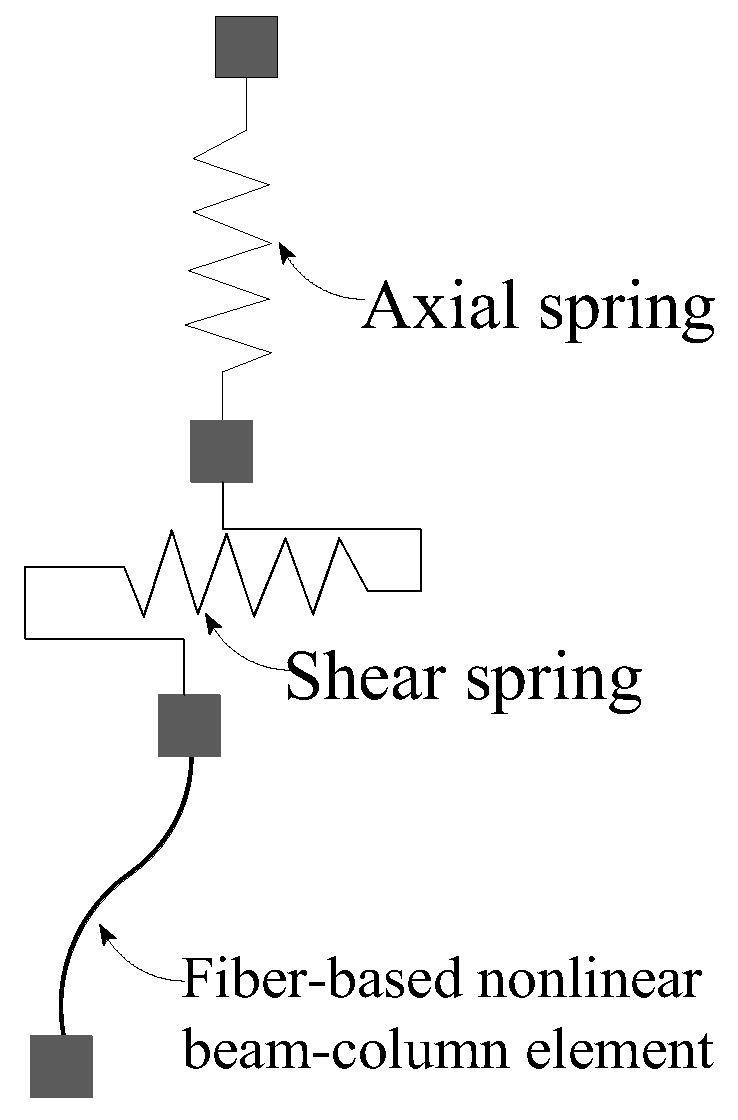


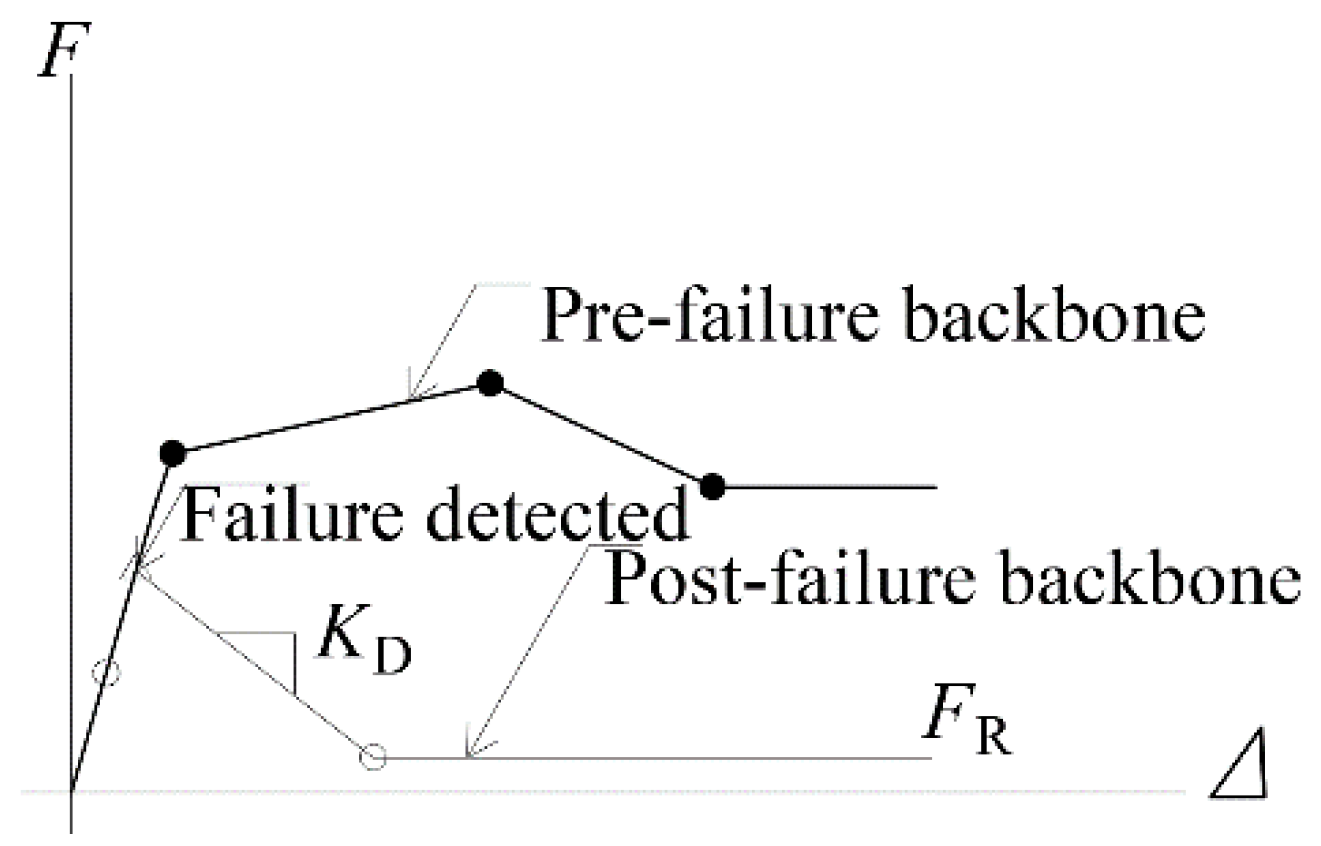
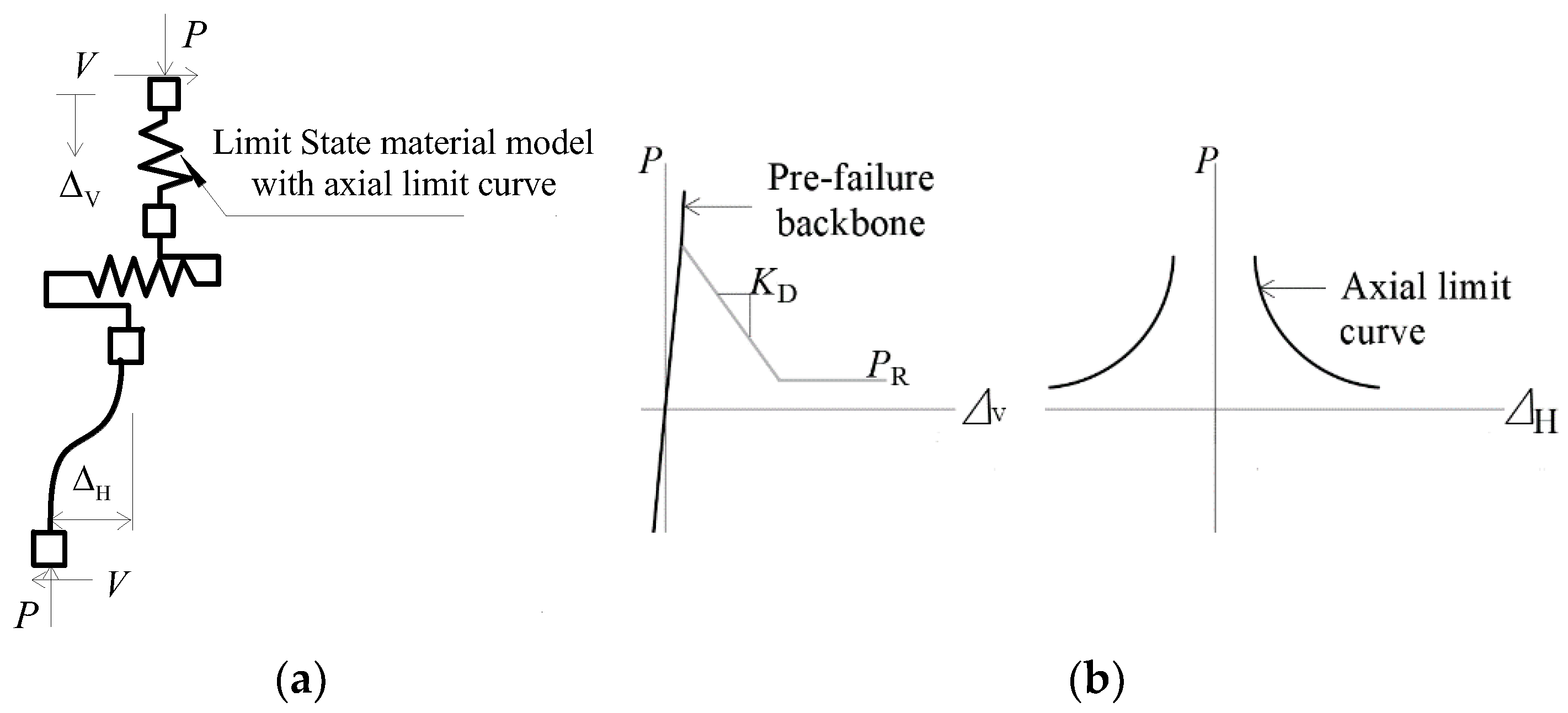
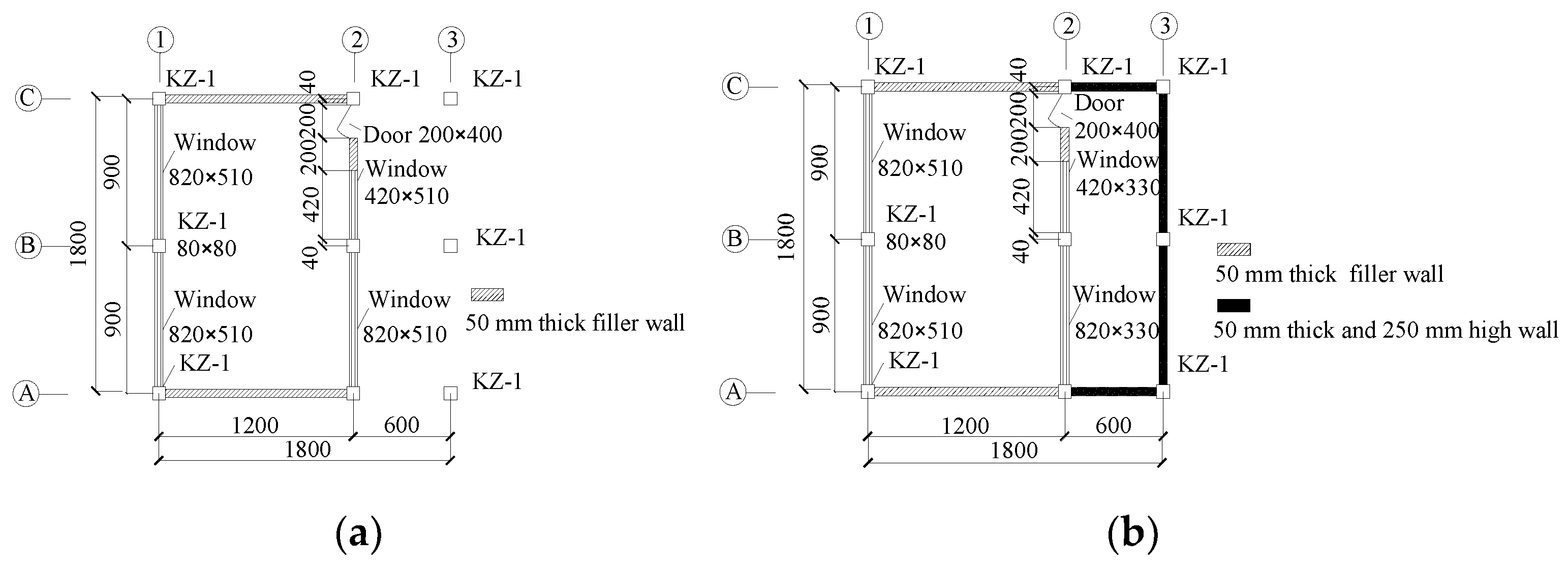
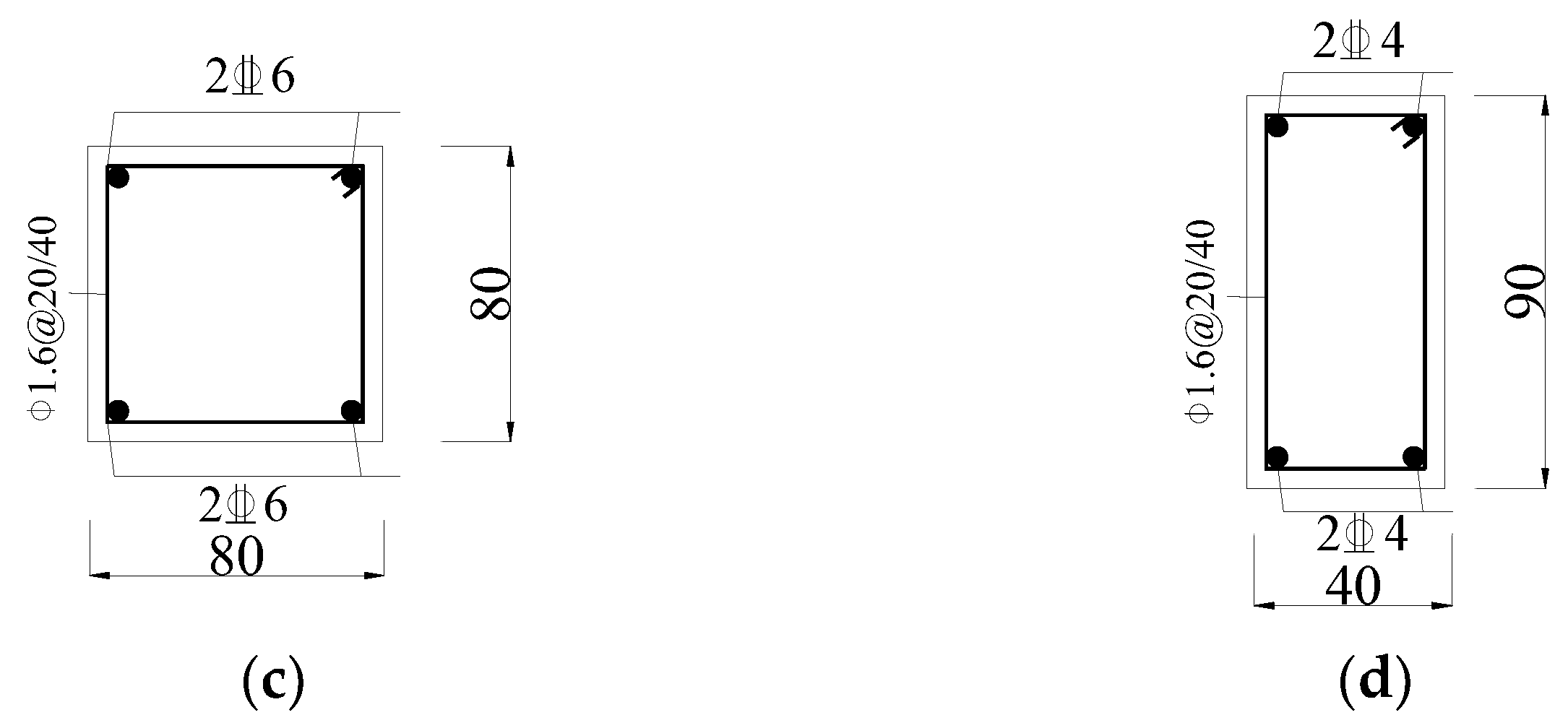


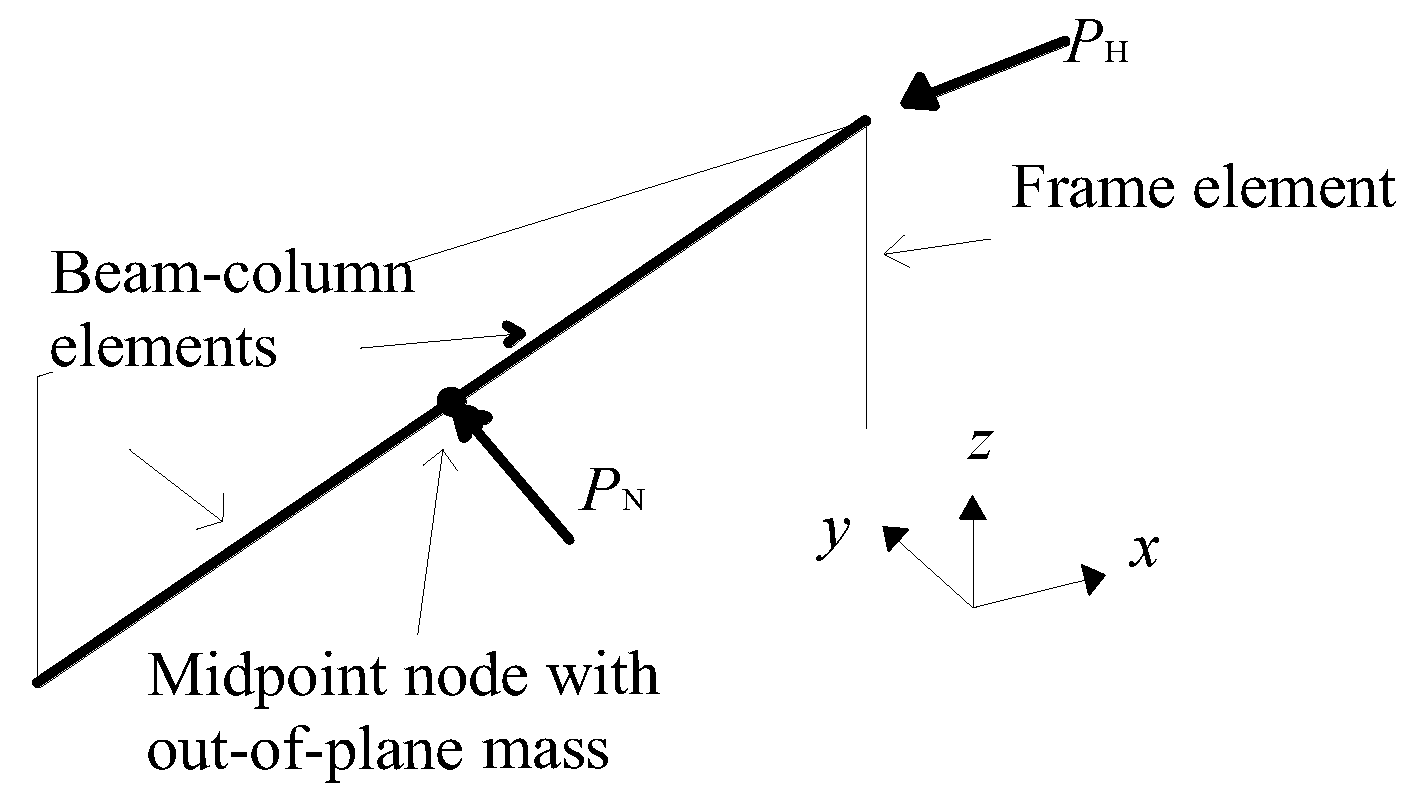
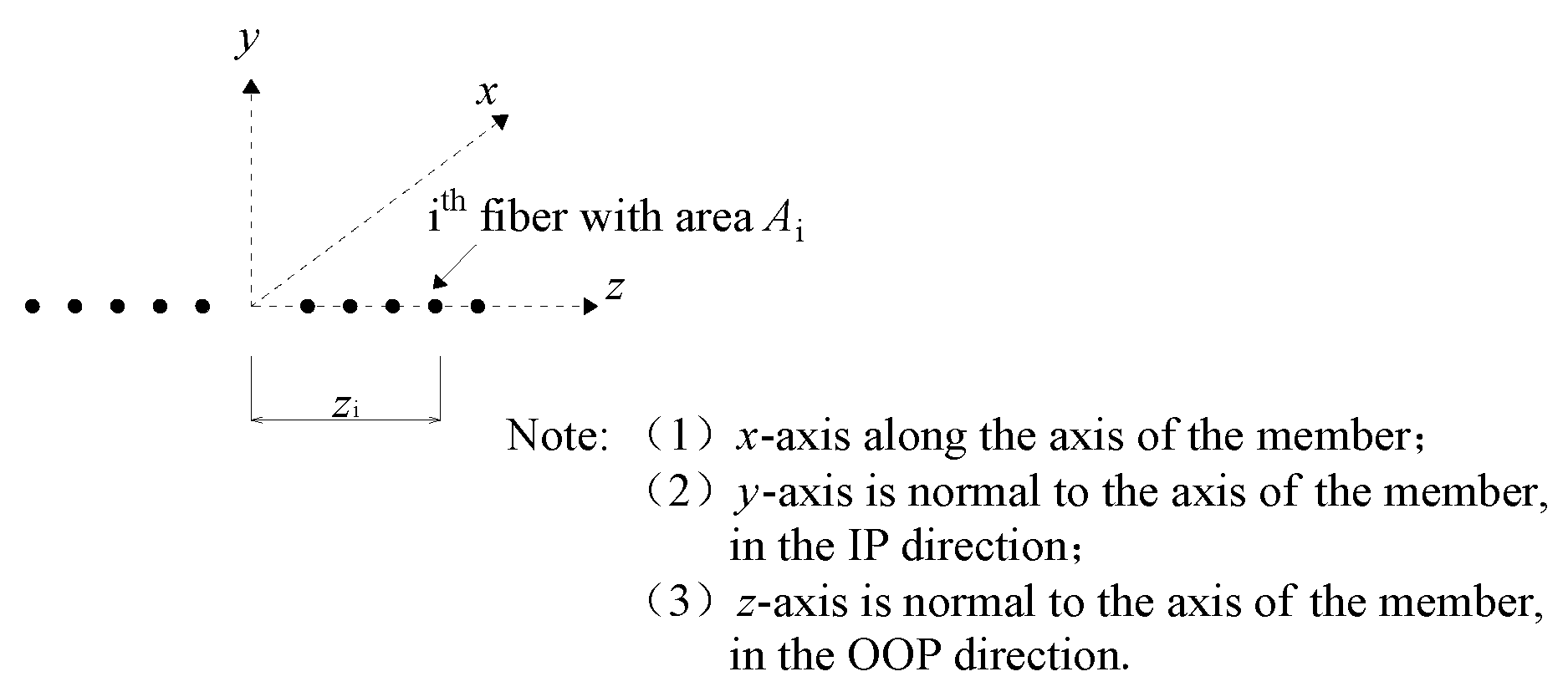


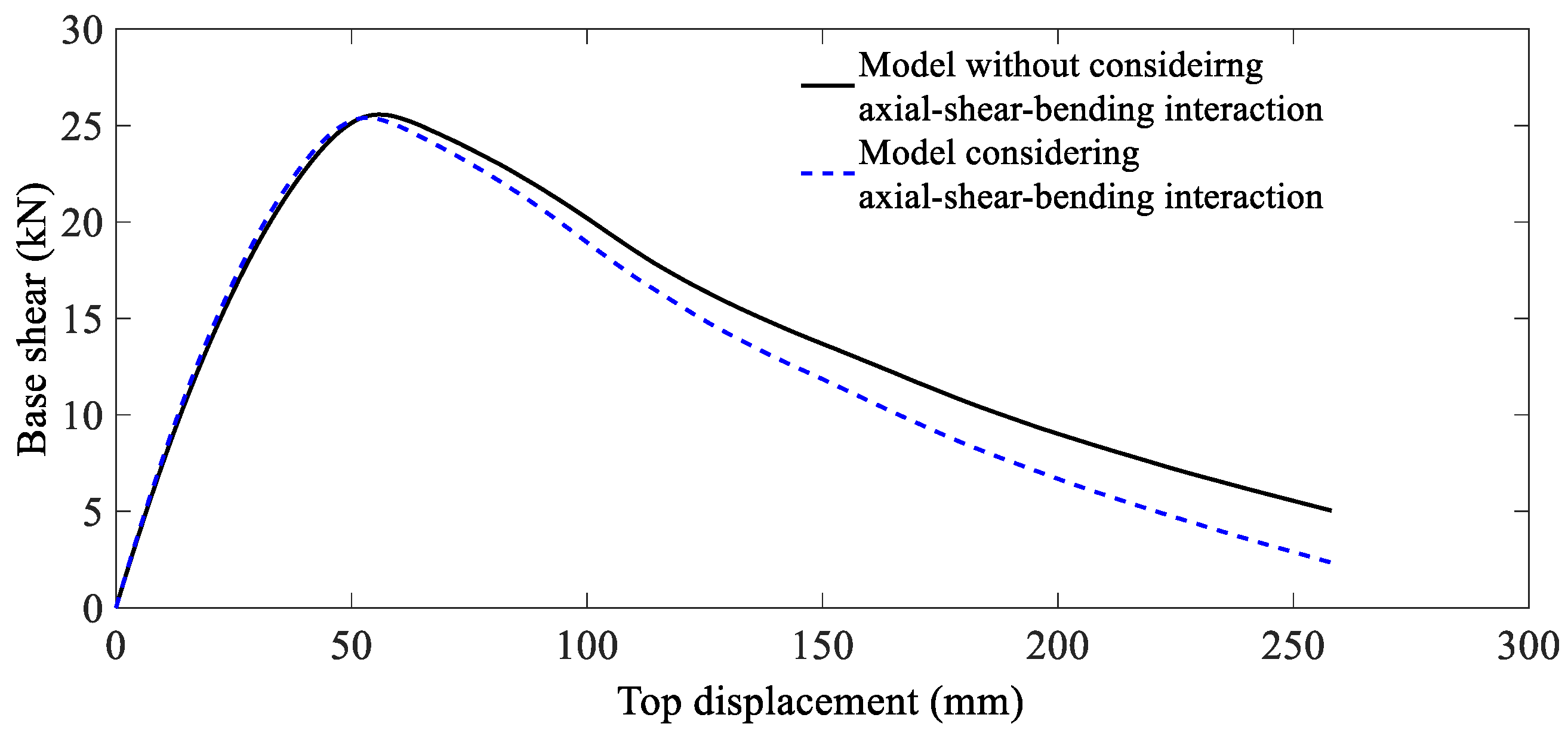

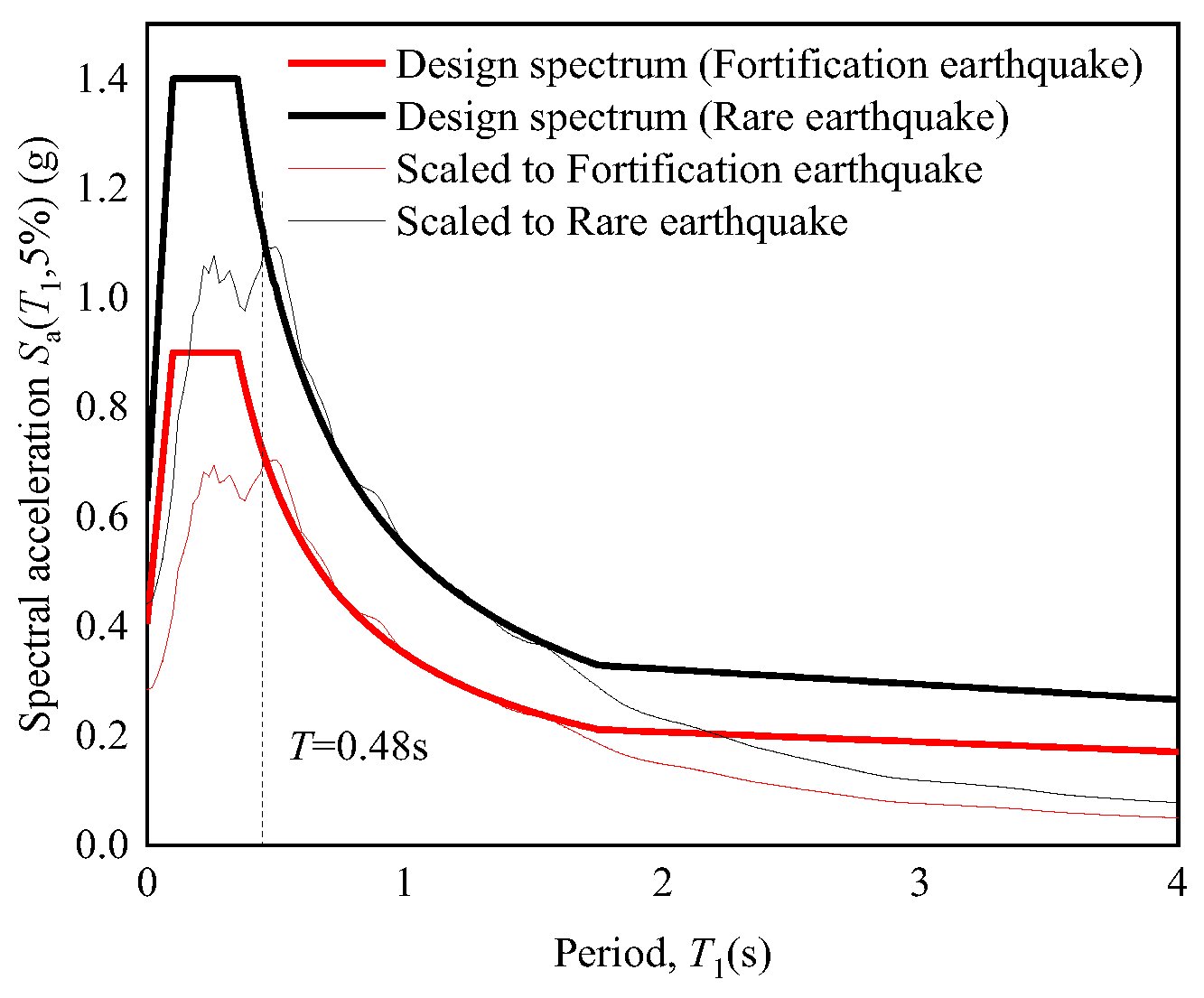
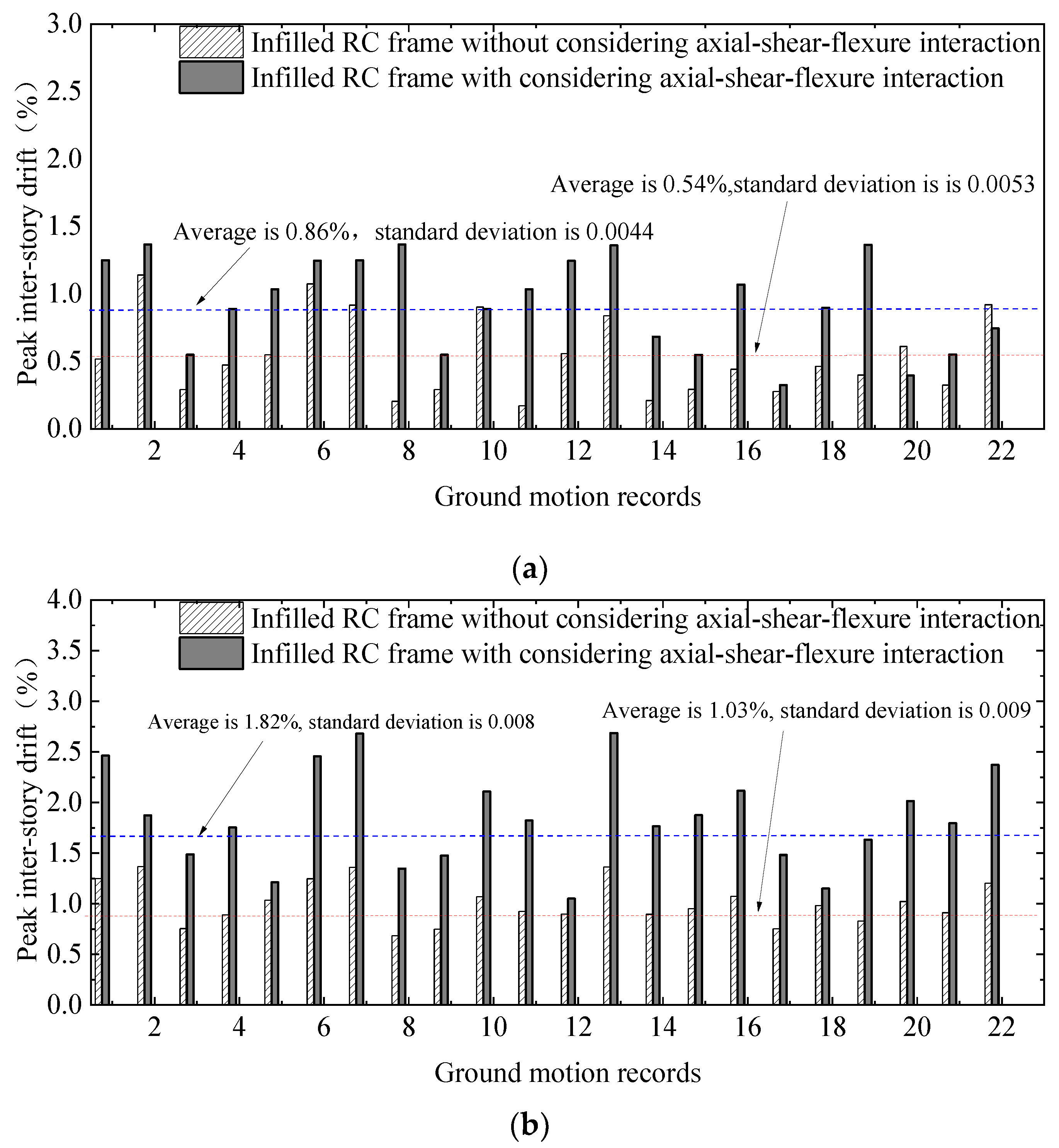


| Diameter | Elasticity Modulus (N/mm2) | Yield Strength (N/mm2) | Ultimate Strength (N/mm2) |
|---|---|---|---|
| 1.6 | 1.82 × 105 | 252.3 | 346.8 |
| 4 | 1.85 × 105 | 360.4 | 422.1 |
| 6 | 1.91 × 105 | 366.9 | 420.3 |
Publisher’s Note: MDPI stays neutral with regard to jurisdictional claims in published maps and institutional affiliations. |
© 2022 by the authors. Licensee MDPI, Basel, Switzerland. This article is an open access article distributed under the terms and conditions of the Creative Commons Attribution (CC BY) license (https://creativecommons.org/licenses/by/4.0/).
Share and Cite
Huang, L.; Han, J.; Wen, H.; Li, C.; He, H.; Luo, Y.; Qian, Z. The Seismic Performance and Global Collapse Resistance Capacity of Infilled Reinforced Concrete Frames Considering the Axial–Shear–Bending Interaction of Columns. Buildings 2022, 12, 2030. https://doi.org/10.3390/buildings12112030
Huang L, Han J, Wen H, Li C, He H, Luo Y, Qian Z. The Seismic Performance and Global Collapse Resistance Capacity of Infilled Reinforced Concrete Frames Considering the Axial–Shear–Bending Interaction of Columns. Buildings. 2022; 12(11):2030. https://doi.org/10.3390/buildings12112030
Chicago/Turabian StyleHuang, Linjie, Jianping Han, Hongwei Wen, Chunyu Li, Haocheng He, Yuxin Luo, and Zhendong Qian. 2022. "The Seismic Performance and Global Collapse Resistance Capacity of Infilled Reinforced Concrete Frames Considering the Axial–Shear–Bending Interaction of Columns" Buildings 12, no. 11: 2030. https://doi.org/10.3390/buildings12112030
APA StyleHuang, L., Han, J., Wen, H., Li, C., He, H., Luo, Y., & Qian, Z. (2022). The Seismic Performance and Global Collapse Resistance Capacity of Infilled Reinforced Concrete Frames Considering the Axial–Shear–Bending Interaction of Columns. Buildings, 12(11), 2030. https://doi.org/10.3390/buildings12112030






